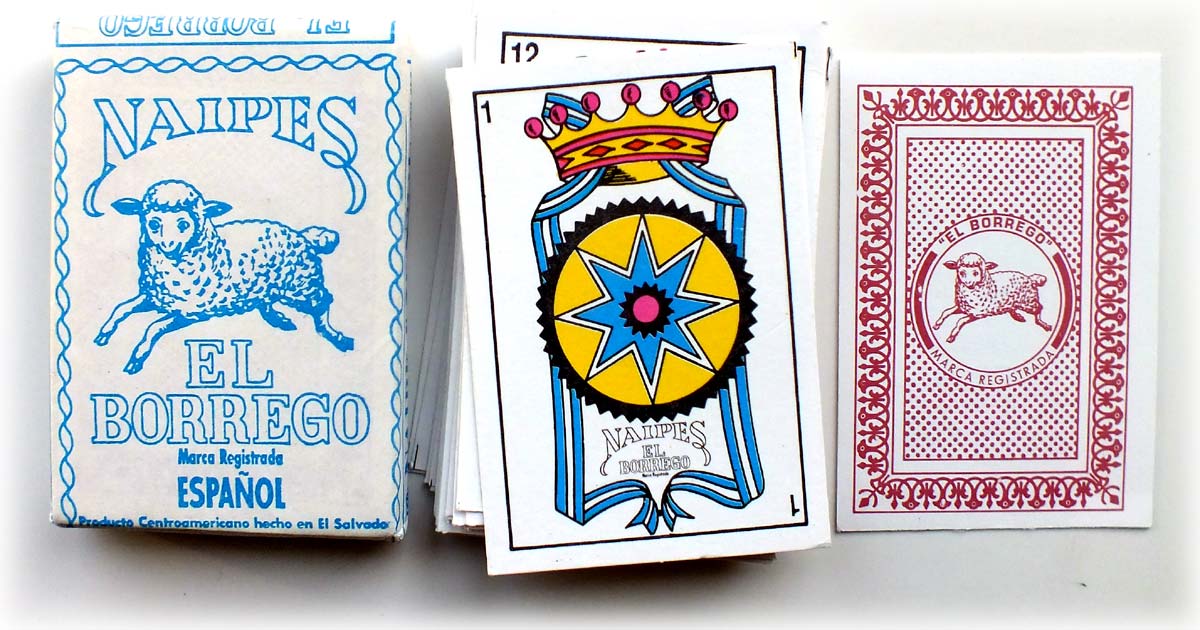Playing Cards in El Salvador
Cards were first imported to Central America from Spain, although local production has always existed. Today El Salvador has some local production of playing cards, which are often of rudimentary quality.
El Salvador was named in 1524 by it's Spanish conqueror, Pedro de Alvardo, after the Holy Saviour. It's people are chiefly of mixed Spanish and Indian blood and speak Spanish. With the neighbouring Spanish-American colonies El Salvador freed itself from Spanish rule in 1821, and with the states of Guatemala, Costa Rica, Honduras and Nicaragua formed the Central American Federation. The Federation was dissolved in 1839 when El Salvador became an independent republic.

Above: Spanish playing cards exported to new Spanish colonies from c.1520 onwards. Cards like these would have been in use in El Salvador for the first 300 years or so after the first Spanish settlers arrived.
"El problema es que no se hacen muchas barajas aqui. Practicamente las unicas que se encuentran son las importadas porque son las que prefieren la gente de aqui. Son de mejor calidad, plastificadas etc. Como las de aqui son muy inferiores en este aspecto pues la gente no las compran y son escasas y solo se encuentra en alguna que otra tiendecita por ahi en el centro"
Cards were first imported to Central America from Spain, although local production has always existed. Today El Salvador has some local production of playing cards, which are often of rudimentary quality. Copies of Fournier's 'Castilian' design, as well as redrawings of the 19th century Cádiz pattern, can be found. Brands include Naipes HISPASA, Naipes El BORREGO and Naipes CISNE.

Above: Naipes Hispasa manufactured in El Salvador by Cartotecnica Centroamericana, S.A. see more →

Above: Naipes El Borrego manufactured in El Salvador see more →

Above: Naipes Cisne manufactured in El Salvador by a local printer imitating Spanish cards see more →


By Simon Wintle
Member since February 01, 1996
I am the founder of The World of Playing Cards (est. 1996), a website dedicated to the history, artistry and cultural significance of playing cards and tarot. Over the years I have researched various areas of the subject, acquired and traded collections and contributed as a committee member of the IPCS and graphics editor of The Playing-Card journal. Having lived in Chile, England, Wales, and now Spain, these experiences have shaped my work and passion for playing cards. Amongst my achievements is producing a limited-edition replica of a 17th-century English pack using woodblocks and stencils—a labour of love. Today, the World of Playing Cards is a global collaborative project, with my son Adam serving as the technical driving force behind its development. His innovative efforts have helped shape the site into the thriving hub it is today. You are warmly invited to become a contributor and share your enthusiasm.
Related Articles

Braulio Fournier
Baraja Nº 1 produced by Braulio Fournier, Burgos, c.1868.

Spanish pattern by Eugène Boisse
Spanish pattern published by Eugène Boisse, Bordeaux.

QAIPES – cartas españolas
Spanish-suited cards made in China inscribed “QAIPES” and “BAIPES”!

Naipes Kukuxumusu
A 52-card Spanish-suited advertising pack for a clothing company in Pamplona.

Spanish-suited deck by J.Y. Humphreys
A rare Spanish-suited deck published by J.Y. Humphreys, Philadelphia, c.1816.

Tík Táck vodka
A brightly coloured pack promoting “Tík Táck” cane vodka from Destileria La Central S.A. in El Salva...

P. Buscaglia: Spanish-suited cards
Spanish-suited cards published by P. Buscaglia, Mele & Genova.

XV Century Spanish-suited playing cards
XV Century Spanish-suited playing cards with moorish influences

Bertschinger y Codina
Fantasy Spanish-suited playing cards by Bertschinger y Codina (Barcelona), c.1850.

Alphonse Arnoult Spanish-suited pack
Luxurious Spanish-suited pack made by Alphonse Arnoult, Paris, France, c.1850.

Clemente Roxas double-ended Spanish pack
Double-ended Spanish-suited playing cards published by Clemente de Roxas in Madrid, 1814.

Antoine de Logiriera
Archaic Spanish-suited playing cards published in Toulouse by Antoine de Logiriera (1495-1518).

J. Deluy c.1490s
Archaic Spanish-suited cards produced by J. Deluy c.1490s.

Wüst Spanish pattern
Wüst Spanish pattern c.1910 advertising Cuban ‘Tropical’ beer.

Hermanos Solesio
“Money Bag” pattern by Hermanos Solesi, late 18th c.

Kem ‘Spanish’ playing cards
Kem ‘Spanish’ playing cards appear to depict Spanish conquistadors © 1994.
Most Popular
Our top articles from the past 28 days

